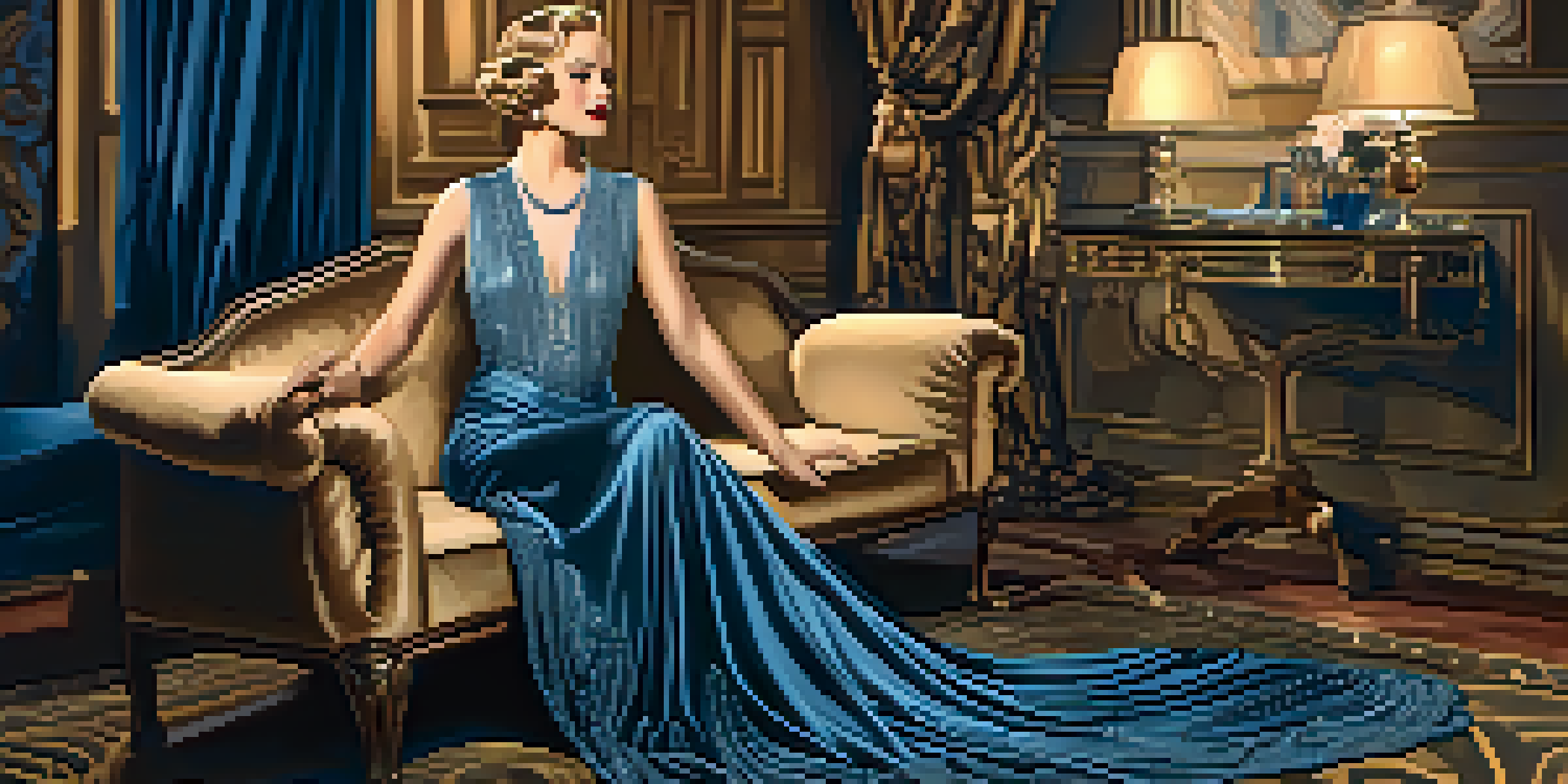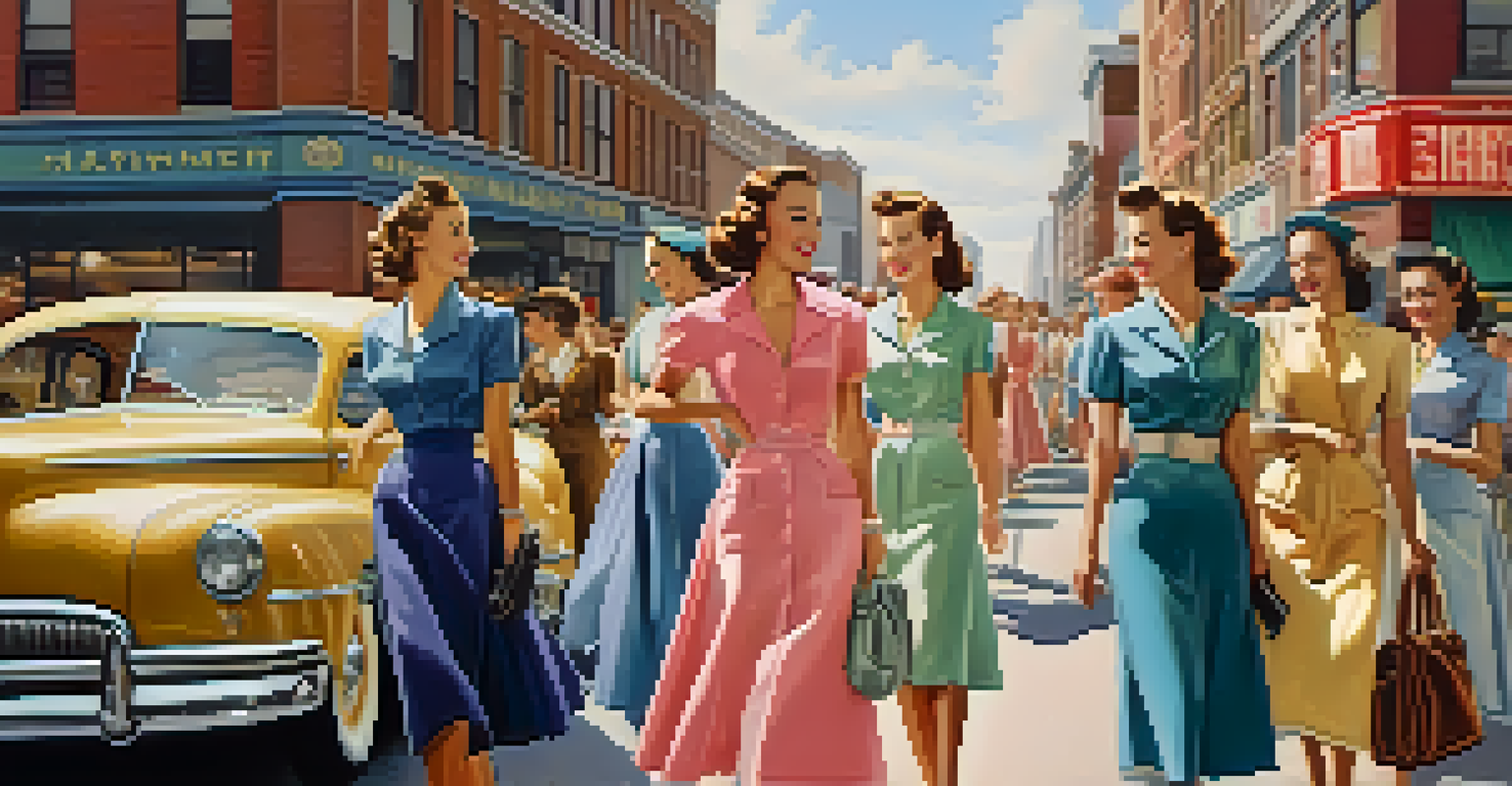Fashion's Evolution: 1930s to 1940s and the Impact of War

The Roaring 30s: Glamour and Elegance in Fashion
The 1930s were a time of glamour, with fashion reflecting the lavish lifestyles of Hollywood icons. Tailored suits for men and flowing gowns for women encapsulated an era of elegance and sophistication. Designers like Coco Chanel and Elsa Schiaparelli introduced bold styles that revolutionized women's fashion, emphasizing femininity and luxury. This trend was celebrated in popular culture, where cinema played a significant role in shaping public perception of fashion.
Fashion is the armor to survive the reality of everyday life.
However, the Great Depression cast a shadow over this luxurious world, pushing many to adopt more practical clothing. Despite financial hardships, people found ways to express their individuality, leading to the rise of thrift and DIY fashion. This era also saw the introduction of synthetic fabrics, which made fashionable clothing more accessible. As society grappled with economic challenges, fashion began to adapt, foreshadowing the changes to come.
By the end of the decade, the optimism of the 30s was abruptly halted by the onset of World War II. As the world plunged into conflict, fashion would have to evolve dramatically, reflecting not just the economic realities but also the societal shifts that war would bring. The carefree glamour of the 30s was soon to be contrasted with the practicality and resourcefulness demanded by the war.
World War II: Functionality Over Fashion
As World War II began in 1939, fashion faced an urgent transformation. The war effort required materials and resources, leading to the rationing of fabric, which significantly impacted clothing design. Designers had to prioritize functionality over frivolity, resulting in more utilitarian garments that could withstand the rigors of daily life during wartime. This shift was not merely about practicality; it was also about a collective mindset that embraced resilience and adaptability.

Women's roles were changing dramatically, as many entered the workforce to support the war effort. This led to the popularization of the 'Rosie the Riveter' look, characterized by sturdy trousers and fitted jackets. The silhouette became more masculine, reflecting women's newfound independence and strength. This was a pivotal moment in fashion history, as the lines between traditional gender roles began to blur, influencing future styles.
Fashion Adapted to Economic Challenges
The 1930s and 1940s saw fashion evolve from glamorous styles to practical designs due to the economic hardships of the Great Depression and World War II.
Even amidst the constraints, creativity flourished. Designers like Christian Dior began to envision a post-war world, dreaming of a return to femininity and elegance. The fashion industry adapted to the limitations imposed by the war while simultaneously laying the groundwork for a vibrant resurgence in the years to come, illustrating the resilience of fashion as a reflection of society's changing dynamics.
The Impact of Rationing on Fashion Design
Rationing during World War II forced designers to rethink their approaches to fashion. With limited materials available, garments became simpler and more streamlined, focusing on essential cuts rather than extravagant details. The concept of 'make do and mend' became popular, encouraging creativity and resourcefulness among the public. This era demonstrated how necessity could inspire innovation, leading to unique designs that merged practicality with style.
In difficult times, fashion is always a way to express yourself and show your individuality.
Fashion houses responded by creating versatile pieces that could be mixed and matched, maximizing the limited fabric available. Dresses were designed with fewer seams and embellishments, and jackets often featured multiple pockets for functionality. This adaptability not only catered to wartime needs but also laid the groundwork for later minimalist trends in fashion. The emphasis on practicality would echo in future decades, showing how war can influence design priorities.
Despite the constraints, some designers managed to retain a sense of style and flair. Evening wear still existed, albeit in simpler forms, with clever use of accessories to elevate basic outfits. This period of rationing proved that fashion could endure even in the toughest times, highlighting the industry’s ability to adapt while still maintaining an essence of creativity and elegance.
Fashion Icons of the Era: Adapting to Change
Throughout the 1930s and 1940s, several fashion icons emerged, embodying the spirit of their times. Actresses like Katharine Hepburn and Vivien Leigh became symbols of strength and resilience, influencing women's fashion with their unique styles. Hepburn’s preference for tailored trousers challenged traditional femininity, paving the way for more liberated expressions of gender through clothing. These icons not only set trends but also reflected the cultural shifts occurring around them.
As the war progressed, figures such as Marlene Dietrich and Rita Hayworth continued to captivate audiences with their bold fashion choices. Their ability to blend glamour with practicality resonated with women who were navigating their new roles in society. The styles they popularized often featured strong silhouettes and incorporated elements of military fashion, subtly acknowledging the ongoing conflict while still celebrating femininity.
Fashion Adaptation During Hardship
The fashion industry transformed from the glamour of the 1930s to more practical designs during World War II, reflecting the economic challenges and changing societal roles.
The emergence of these fashion icons also highlighted the entertainment industry's role in shaping public perception. Their influence reached far beyond the screen, inspiring everyday women to adopt styles that mirrored their favorite stars. This connection between celebrity culture and fashion became a defining characteristic of the era, illustrating how individuals can impact societal norms even amidst turmoil.
The Transition to Post-War Fashion: A Return to Femininity
As World War II came to an end in 1945, the fashion landscape began to shift once again. With the return of peace, there was a collective desire to celebrate femininity and elegance after years of austerity. Designers like Christian Dior introduced the 'New Look' in 1947, characterized by cinched waists and full skirts, which signaled a dramatic departure from the utilitarian styles of wartime. This bold return to opulence marked a new chapter in fashion history.
The New Look not only redefined women's fashion but also symbolized a broader societal shift towards optimism and renewal. Women were encouraged to embrace their femininity, and fashion became a means of expressing newfound freedom and identity. This transition reflected the changing roles of women in society, as they reclaimed their identities after years of wartime sacrifice and labor.
However, this shift wasn't without its challenges. The post-war economic landscape was still shaky, and many women had to balance the desire for fashion with financial realities. The fashion industry had to adapt once again, finding ways to cater to diverse audiences while still promoting the lavish styles that had emerged. This balancing act ultimately set the stage for the dynamic and diverse fashion landscape of the 1950s.
Cultural Influences: Music and Film in Fashion Trends
The 1930s and 1940s were not just about clothing; they were also deeply intertwined with music and film, which significantly influenced fashion trends. The rise of jazz and swing music brought a sense of freedom and excitement, reflected in the vibrant styles of the time. Artists like Billie Holiday and Ella Fitzgerald not only captivated audiences with their voices but also inspired fashion choices that embraced bold colors and playful designs. This connection between culture and fashion created a rich tapestry of expression that resonated with the public.
Film, too, played a vital role in shaping fashion during this period. With the advent of Hollywood, stars became icons, and their styles set trends across the globe. The glamour of the silver screen inspired everyday individuals to emulate the looks of their favorite actresses, reinforcing the idea that fashion was a way to escape reality. Movies provided a visual narrative that captivated audiences, showcasing the transformative power of clothing.
Resilience and Creativity in Design
Rationing during the war led to innovative fashion solutions, emphasizing simplicity and functionality while maintaining a sense of style.
As the war progressed, music and film continued to evolve, reflecting the changing sentiments of society. The emergence of more serious themes in cinema paralleled the realities of wartime life, while still offering moments of escapism through fashion. This interplay between cultural influences and fashion trends established a lasting legacy that continues to shape the industry today, proving that style is often a reflection of the times.
Conclusion: Fashion's Resilience Through Turbulent Times
The evolution of fashion from the 1930s to the 1940s highlights the industry's remarkable resilience amid social and economic upheaval. From the glamorous designs of the 30s to the practical styles of wartime, fashion adapted to reflect the changing needs of society. This adaptability was not just about clothing; it demonstrated the power of fashion as a form of expression, identity, and resistance during challenging times. The ability to innovate under pressure is a testament to the creativity and resourcefulness inherent in the fashion world.
As we reflect on this transformative period, it's essential to recognize how these shifts laid the groundwork for future fashion movements. The interplay between practicality and femininity during and after the war paved the way for a new era of design that celebrated individuality and freedom. The lessons learned from this time continue to resonate in today's fashion landscape, reminding us that style is ever-evolving yet deeply rooted in history.

Ultimately, the story of fashion from the 1930s to the 1940s is a narrative of change, resilience, and creativity. It serves as a reminder that even in the face of adversity, the human spirit can find ways to express itself through art, culture, and, of course, fashion. As we move forward, we carry with us the legacies of those who navigated these turbulent times, continuing to shape the industry with their enduring influence.